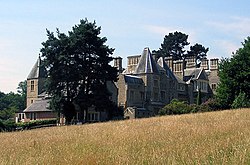Difference between revisions of "Greathed Manor"
(Created page with "{{Infobox house |name=Greathed Manor |county=Surrey |picture=Greathed Manor, near Dormansland, Surrey - geograph.org.uk - 874842.jpg |picture caption=Greathed Manor |os grid r...") |
m |
||
| Line 15: | Line 15: | ||
|condition=Converted to a nursing home | |condition=Converted to a nursing home | ||
}} | }} | ||
| − | '''Greathed Manor''' is a Victorian country house in [[Dormansland]], in the | + | '''Greathed Manor''' is a Victorian country house in [[Dormansland]], in the far south-east of [[Surrey]]. It was designed in 1862-8 by the architect Robert Kerr. |
The house is a Grade II listed building.<ref name=nhle>{{NHLE|1377578|Greathed Manor|Grade=II}}</ref> | The house is a Grade II listed building.<ref name=nhle>{{NHLE|1377578|Greathed Manor|Grade=II}}</ref> | ||
Latest revision as of 13:14, 27 September 2019
| Greathed Manor | |
| Surrey | |
|---|---|
 Greathed Manor | |
| Location | |
| Grid reference: | TQ41324230 |
| Location: | 51°9’45"N, 0°1’11"E |
| Village: | Dormansland |
| History | |
| Built 1862-8 | |
| By: | Robert Kerr |
| Country house | |
| Information | |
| Condition: | Converted to a nursing home |
| Owned by: | Private |
Greathed Manor is a Victorian country house in Dormansland, in the far south-east of Surrey. It was designed in 1862-8 by the architect Robert Kerr.
The house is a Grade II listed building.[1]
History
Greathed Manor, originally called 'Ford Manor', was designed by Robert Kerr for the Spender-Clay family, and was completed in 1868.[1]
The actress Joyce Grenfell was related to the family by marriage and often visited the house. Accounts of her time there are described in her autobiography “Joyce Grenfell Requests the Pleasure”. In 1904 Herbert Spender-Clay, MP and founder of the 1922 Committee, married Pauline Astor, daughter of the American billionaire William Waldorf Astor. The couple lived at the house until 1937.
Ford Manor was requisitioned by the British Government during both World Wars. In the Great War it became a Hospital for wounded American Army officers. In the Second World War it was used as the Headquarters of a Canadian Armoured Division in the run-up to D-Day. In plans drawn up by the German Army for the occupation of Britain after the anticipated success of Operation Sealion, the United Kingdom was divided into various administrative districts. Ford Manor was earmarked to be the Gestapo Headquarters for the Southern District. [1]
The house was renamed 'Greathed Manor' after the widowed Pauline Spender-Clay built a smaller house in the grounds of the original building and requested that the new house be called 'Ford Manor'. The original house was then leased by the Country Houses Association, who renamed the house after their Founder, Admiral Greathed.
The house is currently leased by Pressbeau Limited, and is being run as a private nursing home.[2]
Architecture
Kerr was an influential mid-Victorian architect who wrote The Gentleman's House - Or, How To Plan English Residences, From The Parsonage To The Palace, published in 1864.[3] Kerr's influence was greater than his talent.
The architectural critic Ian Nairn described Greathed as; "over-confident, making no concessions to the landscape or anything else, and without any (...) artistic sincerity".[4] The architectural historian Mark Girouard was no more complimentary, describing the house as "appalling"[5] and Kerr's most significant work, Bearwood House, as of a "design [.] as heavyweight as (its) technology".[6]
The manor is of stone, and mainly of three storeys.[1] Until renovations in 1912, the building had a large porte-cochère at the front, and a winter garden at the rear.[1]
References
- ↑ 1.0 1.1 1.2 1.3 1.4 National Heritage List 1377578: Greathed Manor
- ↑ Choices, N. H. S.. "Contact details, map and directions - Greathed Manor Nursing Home - NHS Choices". http://www.nhs.uk/Services/careproviders/MapsAndDirections/DefaultView.aspx?id=65141.
- ↑ Kerr 2012, p. frontispiece.
- ↑ Nikolaus Pevsner: The Buildings of England: Surrey, 1962; 1971 Penguin Books ISBN 978-0-300-09675-0page 266
- ↑ Girouard 1979, p. 271.
- ↑ Girouard 1979, p. 269.
- Girouard, Mark (1979). The Victorian Country House. New Haven, US: Yale University Press. ISBN 9780300023909. https://books.google.com/?id=dmt6QgAACAAJ&dq=The+Victorian+Country+House.
- Kerr, Robert (2012). The Gentleman's House. Cambridge: Cambridge University Press. ISBN 978-1-108-04484-4. https://books.google.co.uk/books?id=Pl_nE2LhI8oC&printsec=frontcover&dq=editions:nO8j6tkEuRYC&hl=en&sa=X&ved=0ahUKEwjM44uQ1LXUAhWRZ1AKHZjGDk0Q6AEIIjAA#v=onepage&q&f=false.
- Nikolaus Pevsner: The Buildings of England: Surrey, 1962; 1971 Penguin Books ISBN 978-0-300-09675-0